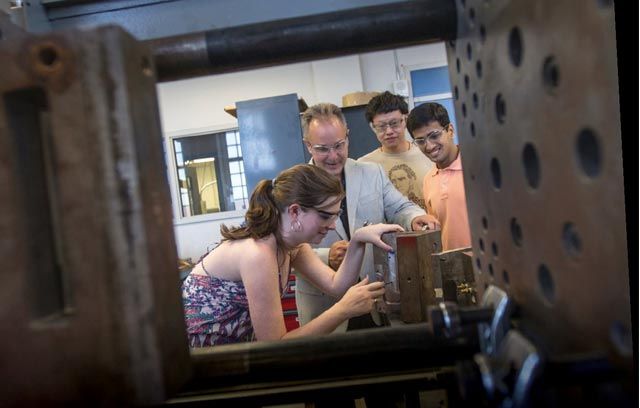From sunglass frames to high-precision optical network connections, plastics are everywhere. More than 85 billion pounds of polymer products are manufactured each year in North America, most by a process known as injection molding, says John P. Coulter, professor of mechanical engineering and mechanics.
Coulter and Ph.D. candidate Qi Li are expanding the scientific understanding of how molten polymers flow through intricate networks of tubes, or “runners,” into the molds for individual parts. Along with other Lehigh participants, such as undergraduate student Lauren Walker, they are collaborating with Beaumont Technologies Inc. (BTI), a company based in Erie, Pa.
The project, which is funded by the National Science Foundation, spans materials science, fluid dynamics and thermodynamics. The researchers are developing techniques to manipulate polymer flows so that parts have consistent quality, which can afford U.S. companies a competitive advantage.
Injection molding forces a molten polymer into a steel mold at high temperature and pressure. The polymer winds through a series of twists and turns to fill as many as 64 product cavities simultaneously, Coulter says. The connecting runners range from 1/8 inch in diameter to 1/2 inch or larger.
Conventional wisdom in the industry says that the runners don’t affect the end result as long as they are “naturally” balanced, meaning the paths to each cavity have the same geometry and maintain similar temperatures. But Coulter’s research with BTI shows that assumption is incorrect.
Inside the machined steel runners, polymers experience shear forces induced by the channel walls. Higher shear strain rates in the outside regions of these flow paths cause the molecules to disentangle so “the material is thinner and flows faster,” Coulter says.
“When you come to a ‘T,’ where the runner splits to feed two new channels, the thin material whips around the tight corners. The slower and relatively thicker central flow region comes later. If you are making 32 products in a mold you have a lot of intersections, and every time you reach one you have a different resulting flow and shear history distribution.” Cavities fill at different rates depending on the mixture of thin and thick polymer flowing to them. In some cases, not all the cavities fill completely.
In 1998, John Beaumont, a professor at the Plastics Engineering Technology program at The Behrend College at Pennsylvania State University in Erie, patented a technique called melt rotation that enables engineers to design channels that manipulate the polymer flow to fill product cavities more consistently. He formed BTI, which licenses the technology to plastics producers.
Melt rotation doesn’t eliminate the problem, Coulter says, but it uses an understanding of the shear imbalance to modify runner junctions to rotate or “flip” the polymer flow by specific angles in order to achieve a desired result.
Coulter and Beaumont began collaborating a decade ago to try to achieve a better understanding of what happens inside injection molds. In their current NSF project, they are particularly interested in improving the filling of cavities with material of identical composition and properties.
Polymers are injected at temperatures of 300 to 500 degrees Fahrenheit, says Coulter. Molding machines apply as much as 200 tons of pressure to counter the force exerted by the material, which can reach tens of megapascals.
The Lehigh team has developed a technique to create molds with sturdy “windows” of polymethyl methacrylate (PMMA) that are optically transparent and can withstand real-world conditions. By placing high-speed video equipment and optically polarizing films inside the molds, researchers can observe temperature differences and molecular orientation in the molten polymer in real time. This enables them to judge the effectiveness of melt rotation techniques in specific applications.
“We have no more mysteries about what is happening inside a steel mold,” Coulter says. “And if you can see what is happening, you can do something to fix it.”
The Lehigh technique enables researchers to compare different melt rotation techniques. BTI has also introduced adjustable melt rotation devices that can be changed as needed.
The joint research project, says Coulter, “is exploring the effects of melt rotation on the properties of the polymer, and not just on the filling of cavities, for the first time.”
Coulter believes the project will change long-held misconceptions in the industry.
“Historically the focus was on understanding what happened inside the cavities,” Coulter says. The assumption that runners are straight pipes, and that intersections don’t matter, he adds, is baked into the computer simulation software that is used in the field.
“If you use simulation codes based on that thinking, you can get beautiful color graphics showing the cavities all filling simultaneously. Then you build the mold and it doesn’t work.
“Even today, there are those who question whether the runners really matter,” Coulter says. His team is providing enhanced scientific analysis of the phenomena that occur in injection molding and evidence that the runners affect the properties of the finished products.
Both Lehigh and BTI have benefited from the collaboration, says Coulter.
“It really makes a difference for the students involved at all levels to connect with and, if possible, spend time in industry. Industry is often focused on making earnings and putting out fires, so connecting to the thorough but traditionally slower-moving university research environment is not always easy.
“This kind of partnership allows us to accomplish what often doesn’t get accomplished.”

